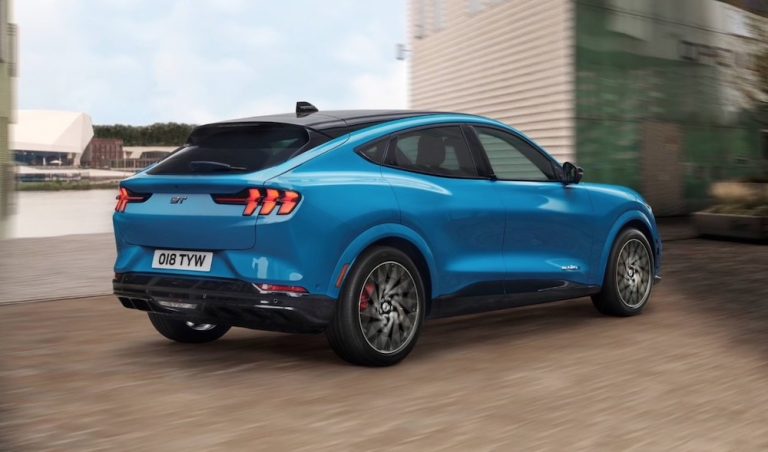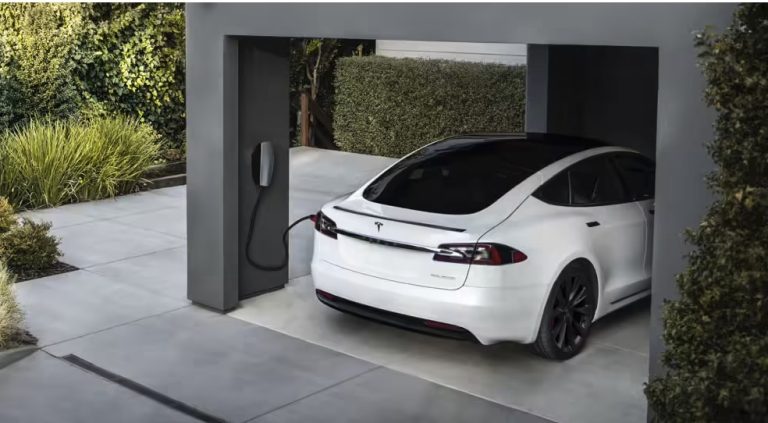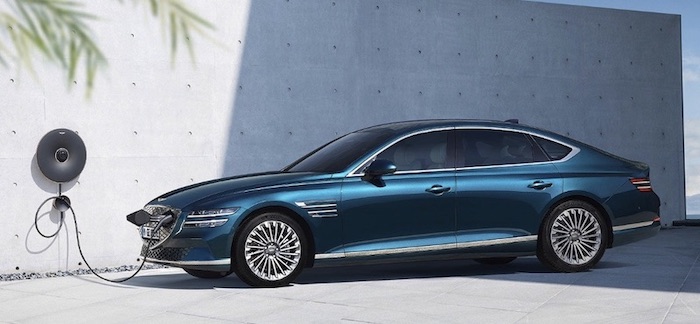Electric Cars: The Basics
For those of you new to zero-emission electric driving, we recommend a read of the following articles:
Sign up to the e-zoomed Electric Living newsletter
The All-Electric Hyundai IONIQ 6 Saloon
The Hyundai Motor Company, is a South Korean automotive manufacturer with a strong global presence (up to 200 countries). The company also has a stake in another leading South Korean automotive company, Kia Corporation. Hyundai has an annual production capacity of over 1.6 million units.
Hyundai commenced developing alternative fuel vehicles in 1988. The first pure electric car was developed by the company in 1991 (Sonata EV). The automotive manufacturer commenced producing hybrid electric vehicles in 2008. The company currently has two battery-electric vehicles (BEVs) and also has two plug-in electric vehicles (PHEVs):
- IONIQ Electric
- Kona Electric
- IONIQ 5 Electric
- IONIQ 6 Electric
- IONIQ Plug-In
- Santa Fe Plug-In
- Tucson Plug-in
Hyundai, has no doubt developed significant experience in the development of electric cars, and the Hyundai IONIQ 5, is a good example of good electric car. However, the automotive manufacturer has been able to make ‘good’ even better in its latest pure electric car, the IONIQ 6. Hyundai is fast cementing an enviable reputation for class-leading electric cars.
Though, the IONIQ 6 and IONIQ 5 have little in common in terms of exterior styling, the two pure electric cars do have much in common in relation to development. In fact, both EVs use the Hyundai- Electric Global Modular Platform (E-GMP), making the IONIQ 6 the second pure electric car to use this dedicated EV platform. The IONIQ 6 has its roots in the Prophecy Concept EV, which was unveiled in 2020. The same year the IONIQ brand was relaunched.
The world premier of the IONIQ 6 was in July 2022, with pre-sales of the First Edition model commencing in November 2022, in key Hyundai markets. According to the company, the First Edition, which is limited to 2,500 units, sold out within 24 hours of its launch.
Given the sleeker exterior styling of the IONIQ 6 electrified streamliner, it should come as no surprise that the EV has improved aerodynamics and vehicle efficiency, compared to the IONIQ 5. In fact, a number of automotive manufacturers are focussing on developing streamlined electric cars. Bottom-line, the more efficient an electric car, the stronger is its proposition to the user!
The IONIQ 6 EV has an ultra-low drag coefficient Cd (0.21). Very few passenger cars can claim a drag coefficient as low as 0.21. One such example is the Lightyear One solar car. The automotive manufacturer claims an aerodynamic coefficient less than 0.20 Cd.
According to the manufacturer, “the sweeping curves and smooth lines pay homage to the iconic streamlined vehicles of the 1920’s and 30’s”. Hyundai has implemented a number of advanced aerodynamic solutions in the IONIQ 6. These include: flush door handles, rear spoiler, front active air flaps, wheel air curtains, wheel gap reducers, separation traps and wheel deflectors.
The IONIQ 6 is available in two EV battery sizes: 53 kWh/ 77.4 kWh. The 53 kWh has a 429 km (WLTP) electric range. The 77.4 kWh EV battery has an e-range between 519 km (AWD) – 614 km (RWD). Even adjusting for real-world driving conditions, all variants offer a useful and practical electric range.
The EV is equipped with an 800-volt battery system. Like the IONIQ 5, the IONIQ 6 also offers ultra-fast DC charging up to 350 kW DC as standard for both variants. The EV can be charged up to 80% between 18 – 36 minutes at 350 kW DC, and can be charged between 43 – 62 minutes at 50 kW DC. Of course, the key is finding a 350 kW public charging station. Hyundai incorporates a 10.5 kW AC (3-phase) onboard charger as standard.
For those of you with access to three-phase power supply at home and work, the 77.4 kWh can be fully charged in 7 hours and 20 minutes. Single-phase EV charging will take longer (11 hours 45 minutes). The charging time for the 53 kWh EV battery will be shorter. We at e-zoomed discourage the use of a 3-PIN domestic plug for charging an electric car.
We also recommend a ‘topping up’ approach to EV charging. This way, charging times are shorter and the regular charging of the EV battery is beneficial for the long-term maintenance of the EV battery. Hyundai offers a warranty up to 8 years or 160,000 km.
The pure electric car is available as both, a 2WD (rear-wheel drive) and an all-wheel drive (AWD). The Hyundai IONIQ 6 77.4 kWh rear-wheel drive can achieve 0-100 km/h in 7.4 seconds (max power: 228 PS), while 77.4 kWh the all-wheel drive can achieve 0-100 km/h in 5.1 seconds (max power: 325 PS). The top speed of the electric vehicle (EV) is 185 km/h. The EV incorporates regenerative braking and one-pedal driving. Hyundai refers to it as i-Pedal.
The exterior styling of the IONIQ 6 is modern, minimalist and elegant. This also extends to the inside cabin. The EV also includes two reclining seats, for those keen on resting while the EV is charging. The EV is technology-filled, to include: 12.3” infotainment screen, 12.3” cluster, head-up display, Hyundai SmartSense advance driver assistance systems, digital side mirror and more. Hyundai has also incorporated over-the-air (OTA) software updates for the EV.
As is now the trend with OEMs, the EV also incorporates sustainable materials, to include: recycled pigment paint from end-of-life tyres in the cladding, bamboo charcoal pigment paint, eco-processed leather, recycled PET fabric, bio PET fabric, bio paint derived from vegetable oils and recycled fishing net carpet.
The EV also incorporates Vehicle-to-Load (V2L) that enables the charging of electric devices using the onboard EV battery. The electric car has a 3-PIN socket that allows charging of electronic items while stationary or driving. Electric devices that can be powered by the EV include: e-bike, e-scooter, laptop, kettle, microwave oven, mini-fridge, blender etc. In terms of practicality, the boot space is up to 401 L (smaller than the IONIQ: 527 L).
Company car drivers can also take advantage of the pure electric car. Bottom-line, electric driving is good for the environment and the wallet!
| PROS | CONS |
|---|---|
| Ultra-low drag coefficient Cd of 0.21 | Small boot space |
| 350 kW DC charging as standard | Only available in one EV battery size |
| Good pure electric range | Roofline impacts headroom for taller rear seat passengers |
The Hyundai IONIQ 6 Saloon (credit: Hyundai)
| At A Glance | |
|---|---|
| EV Type: | Battery-Electric Vehicle (BEV) |
| Vehicle Type: | Saloon |
| Engine: | Electric |
| Available In Ireland: | Yes |
| Variants (4 Options) |
|---|
| Hyundai IONIQ 6 Signature 53kW (from € 48,295) |
| Hyundai IONIQ 6 Signature 77kW (from € 54,315) |
| Hyundai IONIQ 6 Elegance 77kW (from € 62,495) |
| Hyundai IONIQ 6 Finesse AWD 77kW (from € 71,250) |
| EV Battery & Emissions | |
|---|---|
| EV Battery Type: | Lithium-ion |
| EV Battery Capacity: | Available in two battery size: 53 kWh/ 77.4 kWh |
| Charging: | 350 kW DC Rapid Charging (10%-80%: 18-36 mins). Onboard charger: 10.5 kW AC |
| Charge Port: | Type 2 |
| EV Cable Type: | Type 2 |
| Tailpipe Emissions: | 0g (CO2/km) |
| Battery Warranty: | 8 years or 160,000 km |
| Average Cost Of Residential Charging | |
|---|---|
| Battery net capacity: 16.7 kWh | € 4.00 |
| Battery net capacity: 30.0 kWh | € 7.19 |
| Battery net capacity: 39.2 kWh | € 9.39 |
| Battery net capacity: 45.0 kWh | € 10.78 |
| Battery net capacity: 50.0 kWh | € 11.98 |
| Battery net capacity: 64.0 kWh | € 15.34 |
| Battery net capacity: 71.0 kWh | € 17.01 |
| Battery net capacity: 77.0 kWh | € 18.45 |
| Battery net capacity: 90.0 kWh | € 21.57 |
| Battery net capacity: 100.0 kWh | € 23.97 |
- Note 1: The average cost of residential electricity in Ireland varies depending on the region, supplier and type of energy used. An average for Ireland is 23.97 cents/kWh.
- Note 2: Not all EV manufactures make available the data on net EV battery capacity, and in a number of instances the EV battery capacity advertised, does not state if it is gross or net capacity. In general, usable EV battery capacity is between 85% to 95% of the gross available capacity.
| Charging Times (Overview) | |
|---|---|
| Slow charging AC (3 kW – 3.6 kW): | 6 – 12 hours (dependent on size of EV battery & SOC) |
| Fast charging AC (7 kW – 22 kW): | 3 – 8 hours (dependent on size of EV battery & SoC) |
| Rapid charging AC (43 kW): | 0-80%: 20 mins to 60 mins (dependent on size of EV battery & SoC) |
| Rapid charging DC (50 kW+): | 0-80%: 20 mins to 60 mins (dependent on size of EV battery & SoC) |
| Ultra rapid charging DC (150 kW+): | 0-80% : 20 mins to 40 mins (dependent on size of EV battery & SoC) |
| Tesla Supercharger (120 kW – 250 kW): | 0-80%: up to 25 mins (dependent on size of EV battery & SoC) |
- Note 1: SoC: state of charge
| Dimensions | |
|---|---|
| Height (mm): | 1495 |
| Width (mm): | 1880 |
| Length (mm): | 4855 |
| Wheelbase (mm): | 2950 |
| Turning Circle (m): | 11.8 |
| Boot Capacity (L): | 401 |
| 77 kWh 228 PS 2WD | |
|---|---|
| EV Battery Capacity: | 77.4 kWh |
| Electric Range (WLTP): | 614 km |
| Electric Energy Consumption (kWh/100km): | N/A |
| Charging: | 350 kW DC Rapid Charging (10%-80%: 18-36 mins). 50 kW DC charger (10%-80%: 62 mins). Onboard charger: 10.5 kW AC (0%-100%: 7 hrs 20 mins) |
| Top Speed: | 185 km/h |
| 0-100 km/h: | 7.4 seconds |
| Drive: | Rear-wheel drive (RWD) |
| Electric Motor (kW): | 167.7 |
| Max Power (PS): | 228 |
| Torque (Nm): | 350 |
| Transmission: | Automatic |
| Seats: | 5 |
| Doors: | 4 |
| Kerb Weight (kg): | 1,910 – 1,986 |
| Colours: | 11 |
| NCAP Safety Rating: | Five-Star |
| 77 kWh 325 PS AWD | |
|---|---|
| EV Battery Capacity: | 77.4 kWh |
| Electric Range (WLTP): | 519 km |
| Electric Energy Consumption (kWh/100km): | N/A |
| Charging: | 350 kW DC Rapid Charging (10%-80%: 18-36 mins). 50 kW DC charger (10%-80%: 62 mins). Onboard charger: 10.5 kW AC (0%-100%: 7 hrs 20 mins) |
| Top Speed: | 185 km/h |
| 0-100 km/h: | 5.1 seconds |
| Drive: | All-wheel drive (AWD) |
| Electric Motor (kW): | 239 |
| Max Power (PS): | 325 |
| Torque (Nm): | 605 |
| Transmission: | Automatic |
| Seats: | 5 |
| Doors: | 4 |
| Kerb Weight (kg): | 2,020 – 2,096 |
| Colours: | 11 |
| NCAP Safety Rating: | Five-Star |
Top Reasons To Buy A Battery-Electric Vehicle (BEV)
Never have the reasons to buy a pure electric car been more compelling, than in 2023. The past decade has witnessed a significant maturity of all types of electric vehicles (EVs), to include, battery-electric vehicles (BEVs) and plug-in hybrid electric vehicles (PHEVs).
In particular, BEVs have improved significantly, to include: e-range, styling, performance, choice, availability and more! A BEV, also known as a pure electric car, is propelled using energy stored in an EV battery via an electric motor. While a PHEV uses ‘hybrid technology’, to include, an internal combustion engine (ICE) and an electric motor, to propel the vehicle. A BEV does not use an internal combustion engine!
In terms of zero-emission electric range, the latest generation of all-electric cars can achieve between 200 km to 500 km on a single charge. Some even more. As an example, the all-electric Mercedes-Benz EQE saloon has a claimed electric range up to 618 km (WLTP) on a single charge. We can continue to expect further improvements in battery performance and electric range in the coming years.
In terms of style and performance, we are now spoilt for choice across all budget segments. Even the likes of the famed ultra-luxurious automotive manufacturer, Rolls-Royce Motors Cars has joined the race to the migration to pure electric cars.
The all-electric Rolls-Royce Spectre is a defining chapter in the history of the famed luxury automotive manufacturer, as it migrates to the production of electric cars. From 2030, Rolls-Royce will electrify its entire portfolio of luxury cars. The Spectre is the first production pure electric car, which was announced in September 2021. The launch of the Rolls-Royce Spectre is also a defining moment for the global automotive industry!
| Top Reasons To Buy A Pure Electric Car | |
|---|---|
| Tailpipe emissions: | A pure electric car has zero-tailpipe emissions i.e. improves air quality in the immediate area. |
| Cheaper to ‘charge’ than ‘fill’: | Significantly cheaper to recharge a full EV battery, compared to filling a full tank of petrol or diesel. An EV battery can be charged for as little as€10, while filling a tank of fuel is usually over€100! |
| Cheaper running costs: | Cheaper to drive per km, compared to an internal combustion engine (ICE) petrol/ diesel car. An EV costs less than 10 cents per km to drive. |
| Lower maintenance costs: | Lower maintenance costs, compared to aninternal combustion engine petrol/ diesel car. Pure electric cars have fewer moving parts, so less can go wrong! |
| Lower noise pollution: | Lower noise pollution,compared to aninternal combustion engine petrol/ diesel car. Noise pollution is as detrimental to health, as air pollution! |
| Smoother and quieter drive: | BEVs are in general silent, improving the travel experience in the cabin. Moreover, the delivery of power is smoother, further enhancing the driving experience. |
| Instant torque: | Yes certainly, battery-electric vehicles (BEVs) have better torque performance compared to internal combustion engine (ICE) cars. BEVs can deliver immediate torque. The better torque performance of electric cars, further contributes to the ‘fun factor’ in driving an EV, compared to a conventional car. |
| Vast choice for all budgets: | A vast range of fantastic EV available on sale, for all budgets, body types and aspirations. |
| Government grants: | Attractive government subsidies to support the uptake of electric cars. Take advantage while still available. |
While e-zoomed uses reasonable efforts to provide accurate and up-to-date information, some of the information provided is gathered from third parties and has not been independently verified by e-zoomed. While the information from the third party sources is believed to be reliable, no warranty, express or implied, is made by e-zoomed regarding the accuracy, adequacy, completeness, legality, reliability or usefulness of any information. This disclaimer applies to both isolated and aggregate uses of this information.





























